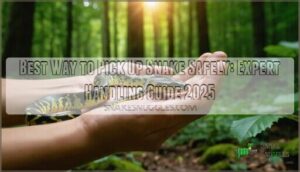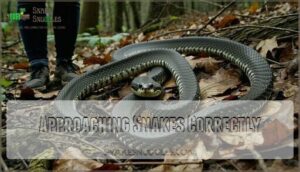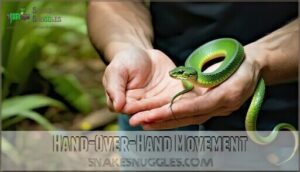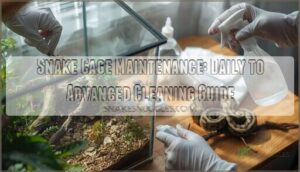This site is supported by our readers. We may earn a commission, at no cost to you, if you purchase through links.

Approach from the side or behind, never from above.
Use a gentle hand-over-hand technique, lifting the snake’s midsection first.
Keep movements deliberate and smooth – sudden jerks trigger defensive responses.
Support the snake’s weight evenly to prevent injury.
For venomous species, always use proper tools like hooks or tongs.
Stay calm and let the snake settle before lifting.
Your confidence matters as much as your technique.
The right approach combines respect for the animal with proven safety methods that experienced handlers swear by.
Table Of Contents
Key Takeaways
- Approach from the side or behind – Never come from above as snakes perceive overhead movement as predator threats, triggering defensive responses.
- Use slow, deliberate movements – Quick motions startle snakes and cause them to become defensive; gradual movements keep both you and the snake calm.
- Support the snake’s body with both hands – Use a hand-over-hand technique to distribute weight evenly across the midsection, preventing injury and stress.
- Use proper tools for venomous species – Always employ snake hooks or tongs when handling dangerous snakes; your safety equipment is non-negotiable.
Safe Snake Handling
Safe snake handling starts with a calm space and the right safety gear. You should move slowly and avoid sudden actions to keep both you and the snake safe.
Calm Environment Importance
If you want smooth snake handling, start with a calm environment.
**Calm environments unlock successful snake encounters—less stress, safer handling for everyone involved.
Quiet surroundings help reduce stress and limit defensive behavior.
Gradual acclimation lets the snake feel safe.
For better reptile safety and snake wellbeing, remember:
- Dim the lights and lower noise.
- Remove sudden movements.
- Let the snake settle before touching.
This supports positive snake behavior and safe handling techniques.
Personal Safety Equipment
You’ll need proper gear before handling any snake.
Snake hooks made from aluminum alloy provide the safest distance from venomous species. Snake tongs offer precise control for smaller reptiles.
Wear thick gloves and protective eyewear to prevent snake bite injuries. Long sleeves and pants provide essential clothing coverage.
Professional reptile safety equipment prioritizes your protection during every snake handling situation. For added safety, consider using snake bite protection gear in snake-prone environments.
Avoiding Sudden Movements
Your movements determine whether a snake feels threatened or secure.
Move with care—your actions decide if the snake stays calm or gets defensive.
Quick motions trigger defensive responses in both venomous snakes and nonvenomous snakes.
Use slow approach techniques with predictable movements.
Gradual introduction helps the snake recognize you’re not a predator.
Mindful handling prevents accidental snake bite incidents.
Keep your snake hook or snake tongs steady.
Calm actions reduce stress for both handler and snake.
Always prioritize snake handling safety to minimize risks, and refer to snake handling safety for more information, ensuring predictable movements and gradual introduction to the snake, which helps in maintaining a safe environment for both the handler and the snake.
Approaching Snakes Correctly
Your approach determines whether a snake views you as a threat or remains calm during handling.
Position yourself to the side or behind the snake rather than approaching from above, which mimics how predators attack in nature.
Side or Rear Approach
When approaching a snake, position yourself to the side or rear of the animal. This technique follows snake perception patterns since snakes view overhead movements as predator threats. Your safe positioning reduces the snake’s defensive response.
Here’s your approach strategy:
- Move to the snake’s side – Position yourself at a 45-degree angle from the snake’s head
- Avoid overhead positioning – Stay level with or slightly behind the snake’s midpoint
- Maintain calm confidence – Your steady movements signal you’re not a threat
This predator avoidance method works for both venomous snakes and nonvenomous snakes during snake handling situations. Snake rescue and snake relocation experts use this minimizing threat technique consistently.
Avoiding Predator Mimicry
Your overhead approach can trigger a snake’s predator alarm system. Snakes perceive shadows from above as bird of prey threats.
This shadow casting activates their natural evasive maneuvers. Approach from the side instead to avoid mimicking aerial hunters.
Snake perception links overhead movement with danger. Proper snake handling during snake rescue and snake relocation requires understanding this response.
Identifying snakes becomes safer when you avoid predator-like positioning. Snake education emphasizes side approaches for successful encounters.
Some harmless species use Batesian mimicry to resemble dangerous ones.
Supporting Snake Body
Picture a rope bridge. You want even weight across the planks.
With snakes, support the mid-body using both hands. Good hand placement keeps the snake steady and helps prevent falls. Allow freedom of movement.
Never grab just the head or tail. This method works for most snake species. It’s key for safe reptile handling and wildlife safety.
Remember to always support snake bodies fully when handling, which is crucial for reptile handling.
Best Pickup Techniques
You need to use the right pickup techniques to keep both you and the snake safe.
Support the snake’s body with your hands and let it move freely without squeezing or holding it too tightly.
Hand-Over-Hand Movement
Once you’ve approached from the side or rear, use a hand-over-hand movement to lift the snake.
Let it make a gentle crawl across your hands. This gives even weight support and allows a smooth shift between hands.
You’ll prevent falls and minimize stress. This technique works well for most snake species and is a core skill in reptile handling and wildlife safety.
Remember to think about safe handling techniques to minimize stress.
Gentle Support Importance
Supporting your snake properly distributes even weight across its body.
This prevents falls and minimizes stress for both you and the reptile.
Gentle support builds handler confidence while ensuring snake comfort.
- Use both hands – One supports the front third, the other cradles the middle section
- Keep movements smooth – Jerky motions trigger defensive responses and reduce snake control
- Match the snake’s pace – Let it move naturally through your hands for better reptile care
Proper support is the best way to maintain control without causing harm.
This technique benefits snake conservation efforts by reducing handling injuries.
Avoiding Restraint
Letting the snake move with freedom of movement is key.
Don’t grip too tightly.
This helps with minimizing stress and supports natural behavior.
When you avoid restraint, you respect the snake’s space.
It’s the best way to build trust.
Gradual acclimation to your touch improves snake control and reptile care.
This approach also supports herpetology and snake conservation.
Snake Hook and Tongs Usage
When you need precise control over snake movement, specialized tools become essential. Snake hooks work best for larger species while tongs provide better grip for smaller or more defensive snakes.
Hook Preference for Large Snakes
Hooks are the best choice for handling large snakes safely. Your snake’s weight determines hook size requirements. Heavy species need wide-headed hooks for proper support.
- Hook size must match your snake’s girth and weight
- Lifting technique should distribute weight evenly across the body
- Species variation affects hook material selection – steel for heavy constrictors
- Herpetology experts recommend L-shaped hooks for girthy snakes
This evaluation guarantees safe handling. Consider the appropriate snake hook dimensions for safe handling.
Tongs for Smaller Snakes
When dealing with smaller snakes, tongs offer superior grip strength and precise control compared to hooks.
The 40-inch length provides ideal size appropriateness for most handlers. Quality tongs material prevents injury prevention issues that cheaper alternatives create.
These tools excel in specific contexts where delicate manipulation matters. Considering a small snake tong is essential for safety.
Understanding the nuances of proper tong usage requires recognizing temporal factors like snake movement patterns. Their meaning extends beyond simple restraint to encompass safe, controlled handling that respects both handler and animal welfare needs.
Prioritizing Human Safety
Your safety-first mindset matters most when handling snakes.
Always use tools like hooks or tongs, especially with venomous species.
Handler experience shapes bite prevention.
Know the context—each snake has its own nuances and ambiguity.
Keep first aid supplies ready for emergencies.
Quick emergency response can save lives.
Never underestimate the meaning of preparation.
Protective eyewear is essential for safeguarding against strikes.
Respect the risks and prioritize your well-being every time.
Minimizing Bite Risk
You can dramatically reduce bite risk by watching your snake’s body language and moving with purpose.
Never startle a snake by approaching from above or making sudden movements near its head.
Monitoring Snake Body Language
Reading snake body language prevents dangerous surprises during handling.
Watch for stress indicators like rapid movement or musking. Defensive postures include S-shaped coiling and hissing.
Agitation signs appear as erratic motion or tail shaking. Calm signals show slow movement and gentle tongue flicking.
Reading cues correctly helps you identify the best approach for safe handling, which can prevent defensive postures and recognize calm signals.
Avoiding Startling Snakes
To avoid startling snakes, use a Quiet Approach and Slow Movements.
Predictable Actions help keep the snake calm.
Watch for Visual Cues like sudden tongue flicks.
Reduce Shadows so you don’t appear as a threat.
Follow this list:
- Move slowly
- Stay quiet
- Approach from the side
- Watch the snake
- Avoid sudden gestures
Proper Equipment Usage
Choose equipment that matches your snake’s size and temperament.
Hook size should correspond to the snake’s body diameter.
Tongs need regular maintenance to guarantee smooth operation.
Store equipment in clean, dry containers to prevent contamination.
Select materials that resist corrosion and provide reliable grip.
The best equipment choice depends on your specific handling situation and safety requirements.
Frequently Asked Questions (FAQs)
What is a snakes greatest weakness?
Temperature is absolutely every snake’s kryptonite! You’ll find they’re cold-blooded creatures who can’t regulate body heat internally. When it gets too cold, they become sluggish and vulnerable.
What snake species are safest for beginners?
Looking for beginner-friendly snakes? Ball pythons top the list. They’re docile and rarely bite.
Corn snakes are equally gentle with simple care needs.
King snakes handle well but need solo housing since they eat other snakes, making them a special case.
How do you identify venomous versus non-venomous snakes?
Like reading nature’s warning signs in a forest, you’ll identify venomous snakes by checking for triangular heads, elliptical pupils, heat-sensing pits, and bright warning colors versus non-venomous snakes‘ rounded features.
What should you do if bitten by snake?
Remain calm and call emergency services immediately.
Don’t try to suck out venom or apply ice.
Keep the bitten area still and below heart level if possible.
Remove jewelry before swelling starts.
How do you release a snake safely?
Like releasing a coiled spring, you’ll slowly lower the snake to the ground.
Support its body gently. Let it crawl away naturally.
Don’t drop or throw it. Move calmly and keep your distance once it’s down, and remember to move calmly.
When is the best time to handle snakes?
You should handle snakes when they’re calm and have digested food for at least 48 hours.
Avoid handling during shedding or right after feeding.
Early evening works best since most snakes are more relaxed and alert then.
Conclusion
Picture yourself standing confidently beside a docile snake. Your hands move with practiced precision.
You’ve mastered the best way to pick up snake safely through patience and proper technique. Remember that slow movements and body support prevent stress for both you and the snake.
Always prioritize safety equipment for venomous species. Your calm demeanor combined with these proven methods guarantees successful handling every time.
Practice builds the confidence that separates nervous beginners from skilled handlers.
- https://www.petmd.com/reptile/general-care/how-to-pick-up-a-snake
- https://reptilesupershow.com/snake-handling-safety-tips-for-secure-encounters/
- https://www.reptiles.swelluk.com/help-guides/aggressive-snake-handling-guide/
- https://virginiaherpetologicalsociety.com/education/edu-docs/some_snake_handling_guidelines_for_beginners.pdf
- https://www.youtube.com/watch?v=QHTXIGRw4a0














